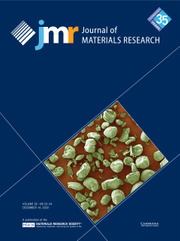Crossref Citations
This article has been cited by the following publications. This list is generated based on data provided by
Crossref.
Baláž, Matej
2014.
Eggshell membrane biomaterial as a platform for applications in materials science.
Acta Biomaterialia,
Vol. 10,
Issue. 9,
p.
3827.
Wang, Anhe
Yang, Yang
Zhang, Xiaoming
Liu, Xingcen
Cui, Wei
and
Li, Junbai
2016.
Gelatin‐Assisted Synthesis of Vaterite Nanoparticles with Higher Surface Area and Porosity as Anticancer Drug Containers In Vitro.
ChemPlusChem,
Vol. 81,
Issue. 2,
p.
194.
Sah, Mahesh Kumar
and
Rath, Subha Narayan
2016.
Soluble eggshell membrane: A natural protein to improve the properties of biomaterials used for tissue engineering applications.
Materials Science and Engineering: C,
Vol. 67,
Issue. ,
p.
807.
Fu, Meifang
Wang, Anhe
Zhang, Xiaoming
Dai, Luru
and
Li, Junbai
2016.
Direct Observation of the Distribution of Gelatin in Calcium Carbonate Crystals by Super‐Resolution Fluorescence Microscopy.
Angewandte Chemie,
Vol. 128,
Issue. 3,
p.
920.
Fu, Meifang
Wang, Anhe
Zhang, Xiaoming
Dai, Luru
and
Li, Junbai
2016.
Direct Observation of the Distribution of Gelatin in Calcium Carbonate Crystals by Super‐Resolution Fluorescence Microscopy.
Angewandte Chemie International Edition,
Vol. 55,
Issue. 3,
p.
908.
Torres-Man, A.C.
and
Delgado-Me, E.
2017.
Influence of Separation Techniques with Acid Solutions on the Composition of Eggshell Membrane.
International Journal of Poultry Science,
Vol. 16,
Issue. 11,
p.
451.
Khan, Muhammad Umair
Hassan, Gul
and
Bae, Jinho
2019.
Bio-compatible organic humidity sensor based on natural inner egg shell membrane with multilayer crosslinked fiber structure.
Scientific Reports,
Vol. 9,
Issue. 1,
Shi, Yaning
Zhou, Kai
Li, Dandan
Guyonnet, Vincent
Hincke, Maxwell T.
and
Mine, Yoshinori
2021.
Avian Eggshell Membrane as a Novel Biomaterial: A Review.
Foods,
Vol. 10,
Issue. 9,
p.
2178.
Oyen, Michelle L.
2021.
Multiscale Mechanics of Eggshell and Shell Membrane.
JOM,
Vol. 73,
Issue. 6,
p.
1676.
Pillai, Mamatha M.
Saha, Rituparna
and
Tayalia, Prakriti
2023.
Avian eggshell membrane as a material for tissue engineering: A review.
Journal of Materials Science,
Vol. 58,
Issue. 16,
p.
6865.
Torres-Mansilla, Adriana
Hincke, Maxwell
Voltes, Ana
López-Ruiz, Elena
Baldión, Paula Alejandra
Marchal, Juan Antonio
Álvarez-Lloret, Pedro
and
Gómez-Morales, Jaime
2023.
Eggshell Membrane as a Biomaterial for Bone Regeneration.
Polymers,
Vol. 15,
Issue. 6,
p.
1342.
Gavali, Shivani
Gavali, Pranali
Kasved, Ashwini
and
Kengar, Seema
2024.
Concise Review on Integral Structure of Egg Shell Membrane.
Research Journal of Science and Technology,
p.
137.
Wang, Minjie
Tian, Yi
Tong, Xiao
Lou, Tingfei
Xu, Zhikang
Huang, Xiaojun
Li, Changjie
and
Xu, Liang
2025.
PDMS membranes with bioinspired mineral coatings for the enhancement of microbial adhesion and nitrogen removal performance in MABR system.
Applied Surface Science,
Vol. 685,
Issue. ,
p.
161998.


